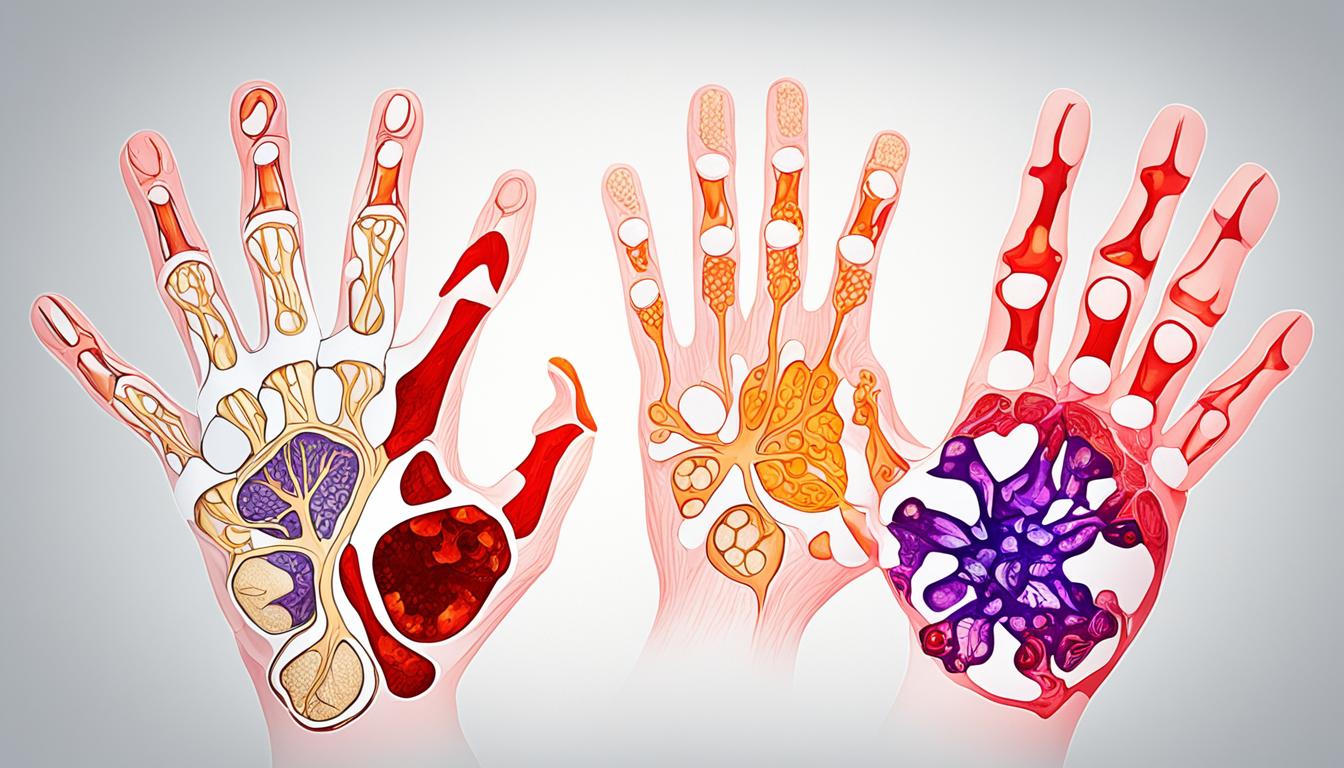Systemic sclerosis, also known as scleroderma, is a rare ailment. It’s an autoimmune disorder affecting the skin, joints, and organs. This condition’s main feature is an abnormal immune response. We don’t know the exact cause. People with this may see swelling and color changes in their fingers. They may also have stiff joints and damage to important organs like the lungs and kidneys.
Doctors often look for certain antibodies in the blood to diagnose this illness. Right now, there’s no cure. But we can manage symptoms and keep organ damage to a minimum. Stem cell therapy is an exciting treatment. It works by healing tissues and fixing the immune system. This can lead to a better quality of life for those affected.
Key Takeaways:
- Systemic sclerosis is a rare autoimmune connective tissue disorder affecting the skin, joints, and internal organs.
- Common symptoms include finger swelling, discoloration, joint contractures, and organ damage.
- Diagnosis involves identifying specific antibodies in the blood.
- Treatment options focus on managing symptoms and limiting organ dysfunction.
- Stem cell therapy shows promise for repairing damaged tissues and modulating immune responses.
The image above shows how systemic sclerosis affects different parts of the body.
Types and Subtypes of Systemic Sclerosis
Systemic sclerosis is a type of complex autoimmune disorder. It affects connective tissues and shows up in many ways. By understanding how it varies among different people, doctors can diagnose and treat it better.
Limited Systemic Sclerosis / CREST Syndrome
One form is limited systemic sclerosis, known as CREST syndrome. CREST stands for five common signs:
- Calcinosis
- Raynaud’s phenomenon
- Esophageal dysmotility
- Sclerodactyly
- Telangiectasia
This type mainly hurts the skin and certain places like the face and hands. It moves slowly and often comes with GERD and problems with the heart.
Diffuse Systemic Sclerosis
Another type is diffuse systemic sclerosis. This one harms the skin a lot and can get worse quickly. It’s linked with Raynaud’s syndrome, which makes blood slow to the fingers.
It can also hurt the stomach and lungs, causing problems like trouble swallowing or lung scarring.
Systemic Sclerosis Sine Scleroderma
Systemic sclerosis sine scleroderma is rare. It mainly affects organs inside the body, not the skin. Without the usual skin symptoms, it can be hard to diagnose.
But it can still harm the heart, lungs, kidneys, and digestive system. Each organ might have its own problems.
It’s key for doctors to know the types and kinds of systemic sclerosis. That way, they can plan the best treatment for each person. This approach can help lessen symptoms, avoid issues, and improve life quality.
Managing Systemic Sclerosis and Future Directions
The management of systemic sclerosis uses many experts to ease symptoms and save organs. It’s crucial to watch closely and find issues early. This helps doctors act fast to keep things from getting worse.
Biomarkers are key in spotting and predicting what happens with this disease. By looking at certain antibodies and protein levels, doctors get hints about how severe it is. This lets them make plans to treat each person in a way that fits them best.
Using stem cells to treat systemic sclerosis is fairly new but promising. Studies are looking at how safe and helpful this method can be. Stem cell therapy hopes to fix damaged areas and balance the immune system, which could really help patients.
Finding the disease early is still the best way to help patients do well. It stops organs from getting permanently damaged and helps with symptoms. But to get even better at treating systemic sclerosis, we need to keep learning more and developing new, focused treatments.
FAQ
Q: What is systemic sclerosis?
A: Systemic sclerosis, also called scleroderma, is a rare issue. It affects the skin, joints, and organs. It is an autoimmune condition.
Q: What are the symptoms of systemic sclerosis?
A: People might have swollen fingers or joint tightness. They could also notice their fingers changing colors. Damage to internal organs is another potential symptom.
Q: What causes systemic sclerosis?
A: The exact cause is not clear. It is thought to be due to a problem with the immune system reacting incorrectly.
Q: How is systemic sclerosis diagnosed?
A: Doctors often find it by testing your blood. They look for specific types of antibodies. This helps confirm the diagnosis.
Q: What are the treatment options for systemic sclerosis?
A: While systemic sclerosis can’t be cured, its symptoms can be managed. There are various ways to treat the disease and protect the organs.
Q: Can stem cell therapy be used to treat systemic sclerosis?
A: Yes, stem cell therapy is showing good results in treating systemic sclerosis. It helps repair harm and balances the immune system.
Q: What are the types and subtypes of systemic sclerosis?
A: Systemic sclerosis has different types. They include CREST syndrome, diffuse systemic sclerosis, and another type called systemic sclerosis sine scleroderma.
Q: How is systemic sclerosis managed?
A: Treating systemic sclerosis takes a team. The goal is to ease symptoms, stop issues, and keep the organs working well.
Q: What are the future directions for managing systemic sclerosis?
A: The future aims to use biomarkers for better diagnosis. It also plans for custom treatment plans. Plus, it’s looking into the safety and effectiveness of stem cell therapy through more studies.
Q: Why is early diagnosis important in systemic sclerosis?
A: Finding the disease early can help a lot. It lets doctors start treatment sooner. This can make a big difference in how well a patient does.

